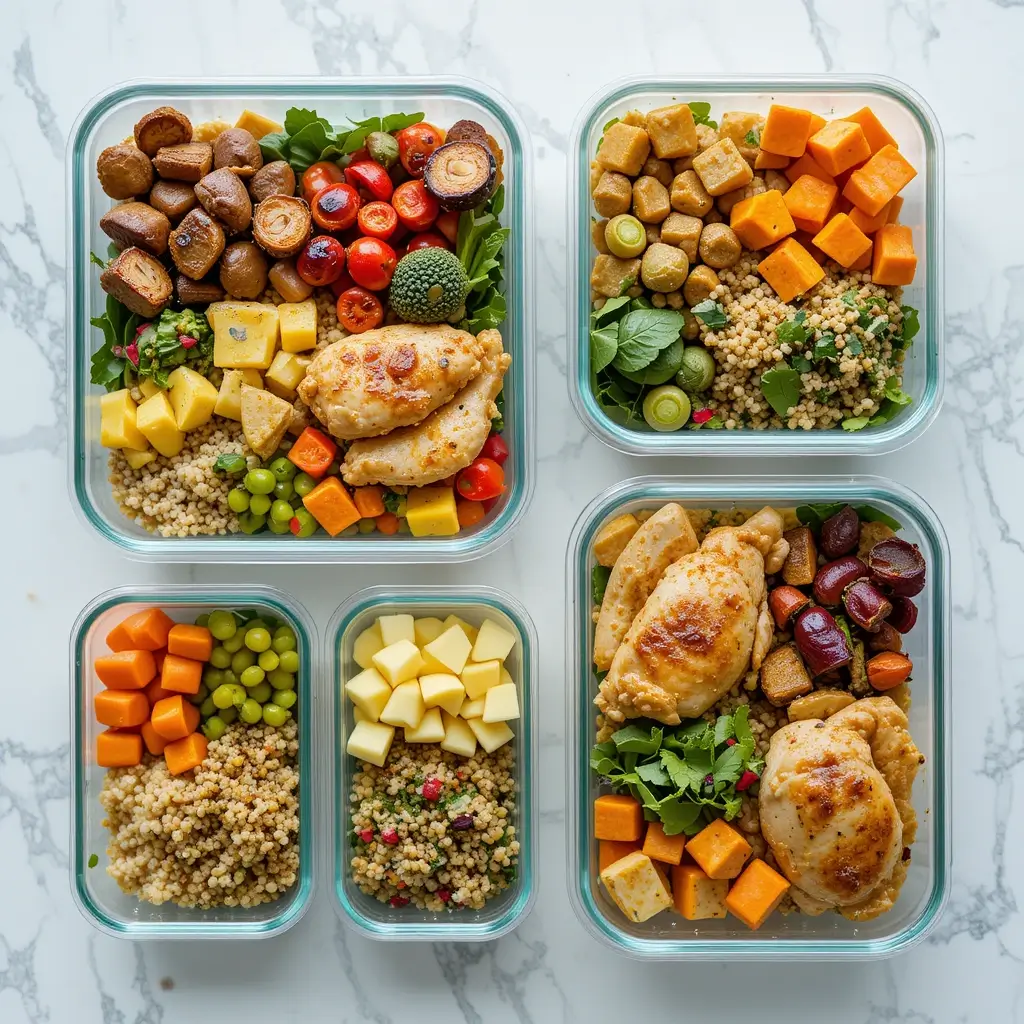Are you tired of feeling overwhelmed by complex diet plans and endless health advice? Embracing simple healthy eating habits can transform your lifestyle without the stress. Whether you’re trying to figure out how to eat healthy daily or looking for practical tips to create a healthy lifestyle eating routine, you’re in the right place!
Healthy eating doesn’t have to be complicated or expensive. In fact, small, consistent changes—like choosing whole foods over processed options or staying hydrated—can make a big difference in your energy, mood, and overall well-being. Plus, with the right strategies, you can enjoy delicious meals while still nourishing your body.
In this blog post, we’ll explore 10 simple healthy eating tips designed to fit seamlessly into your busy lifestyle. From easy meal-planning hacks to mindful eating techniques, these tips will help you achieve a balanced diet without sacrificing flavor or convenience. Ready to make healthy eating a natural part of your day? Let’s get started!
Table of Contents
How to Start Eating Healthy: Simple Steps for Beginners
Focus on Whole Foods Over Processed Options
If you’re looking for a straightforward way to improve your eating habits, focusing on whole foods over processed options is a game changer. Whole foods—like fresh fruits, vegetables, whole grains, and lean proteins—are packed with nutrients your body craves. Processed foods, on the other hand, often come loaded with added sugars, unhealthy fats, and artificial ingredients that do little to fuel your body or support your long-term health.
Why Choose Whole Foods?
Imagine this: instead of reaching for a bag of chips when hunger strikes, you grab a handful of raw almonds or a juicy apple. Not only are these whole foods satisfying, but they also provide fiber, vitamins, and minerals that processed snacks can’t compete with. Whole foods are nature’s original fast food—simple, delicious, and brimming with goodness.
Processed foods might be convenient, but they often lack the nutritional punch you need. For example, while instant ramen may be quick, swapping it for a homemade quinoa salad with roasted veggies and olive oil offers sustained energy, better digestion, and long-term health benefits.
Tips to Make the Switch
- Start Small: You don’t have to overhaul your pantry overnight. Begin by swapping one processed item per week with a whole food alternative. For example, replace sugary breakfast cereals with overnight oats topped with fresh berries.
- Shop the Perimeter: In most grocery stores, whole foods like fresh produce, meats, and dairy are located around the outer aisles. Stick to these sections to naturally avoid heavily processed options.
- Experiment with Recipes: Cooking with whole foods doesn’t have to be boring. Try roasting sweet potatoes with a sprinkle of cinnamon, tossing kale with lemon and garlic for a quick salad, or making your own granola with oats, nuts, and honey.
A Personal Touch
I remember my first attempt at ditching processed snacks—I swapped my favorite potato chips for air-popped popcorn sprinkled with nutritional yeast. At first, it felt like a big sacrifice, but I quickly realized how much better I felt. The energy boost and sense of satisfaction were undeniable!
What Are Your Go-To Whole Foods?
Practice Portion Control
Portion control is one of the most underrated strategies for maintaining a healthy diet. It’s not just about what you eat but how much you eat that makes a difference. Even the healthiest foods can contribute to weight gain or sluggishness if consumed in excess. Learning to manage portions is a skill that can help you enjoy all your favorite meals without overindulging—and it’s easier than you think!
Why Does Portion Control Matter?
Think about this: A single serving of nuts is about a small handful, but it’s easy to eat double or even triple that while snacking mindlessly. The result? Extra calories that can add up quickly. Portion control helps prevent overeating, reduces food waste, and keeps you mindful of your body’s hunger and fullness cues. It’s a key habit for maintaining a balanced, healthy lifestyle.
Simple Tips for Mastering Portion Control
- Use Smaller Plates and Bowls
Research shows that using smaller dinnerware can trick your brain into feeling satisfied with less food. A full plate—whether it’s a large or small one—signals abundance, so downsizing your dishes naturally encourages smaller portions. - Learn Serving Sizes
Get familiar with standard serving sizes for common foods. For example:- 1 serving of protein: the size of a deck of cards.
- 1 serving of cooked pasta or rice: about half a cup, or the size of a tennis ball.
- 1 serving of fruits or veggies: roughly the size of your fist.
- Pre-Portion Snacks
Instead of eating straight from a bag or box, portion out snacks like trail mix, popcorn, or chips into small containers. This prevents mindless overeating and helps you stay in control. - Listen to Your Body
Eat slowly and pay attention to when you feel satisfied—not stuffed. It takes about 20 minutes for your brain to register fullness, so slowing down can help you avoid overeating.
My Portion Control Journey
I used to pile my plate high at every meal, thinking I needed a lot to feel satisfied. But when I started using smaller plates and paying attention to serving sizes, I realized how little I actually needed to feel full. One of my favorite tricks? Measuring out a serving of ice cream into a small bowl—it still feels indulgent but keeps my portions in check!

Staying hydrated is one of the simplest yet most impactful habits for maintaining overall health. Water plays a vital role in everything from digestion and energy levels to skin health and brain function. Despite its importance, many of us don’t drink enough water daily, often mistaking thirst for hunger or simply forgetting to sip throughout the day.
Why Hydration Matters
Did you know that even mild dehydration can cause fatigue, headaches, and difficulty concentrating? Proper hydration helps your body function at its best by regulating temperature, flushing out toxins, and keeping your joints and muscles working smoothly. Plus, staying hydrated can support healthy eating habits by curbing unnecessary snacking—often, when you think you’re hungry, you’re just thirsty!
Easy Ways to Stay Hydrated
- Start Your Day with Water
Kick off your morning by drinking a glass of water before coffee or breakfast. This helps rehydrate your body after a night of rest and jumpstarts your metabolism for the day. - Carry a Reusable Water Bottle
Having a water bottle on hand makes it easy to sip throughout the day, whether you’re at work, running errands, or hitting the gym. Opt for one with measurements to track your intake. - Add Flavor Naturally
If plain water feels boring, jazz it up by adding slices of lemon, cucumber, mint, or berries. These natural flavors make water more enjoyable without added sugar or calories. - Set Hydration Goals
Aim for at least 8 cups (64 ounces) of water a day, though your needs may vary based on activity level and climate. Use apps or set alarms as reminders to drink regularly. - Incorporate Hydrating Foods
Foods like watermelon, cucumbers, oranges, and strawberries have high water content, making them excellent choices for boosting hydration while snacking.
My Hydration Hack
I used to struggle with drinking enough water, especially during busy days. Then I started a habit of taking a few sips every time I checked my phone or opened my email—it worked like a charm! Over time, it became second nature, and now I feel more energized and focused throughout the day
Healthy Eating Habits for Long-Term Success

Plan Your Meals Ahead
Meal planning is the secret weapon for anyone looking to maintain a healthy diet while saving time, money, and stress. By planning your meals ahead, you can ensure you’re eating nutritious, balanced dishes throughout the week and avoid the temptation of last-minute unhealthy choices. Whether you’re a busy professional, a parent managing multiple schedules, or just looking for more structure in your eating habits, meal planning can be a game-changer.
Why Meal Planning Works
Planning your meals ahead eliminates the guesswork and helps you stay on track with your health goals. It also reduces food waste and makes grocery shopping more efficient since you’ll know exactly what you need. Plus, having prepped meals on hand means you’re less likely to reach for takeout or processed convenience foods.
Steps to Get Started
- Set Aside Time to Plan
Dedicate 15–30 minutes each week to map out your meals. Consider your schedule and plan easy, quick recipes for busy nights while reserving more elaborate meals for when you have extra time. - Create a Balanced Menu
Ensure your plan includes a variety of food groups: lean proteins, whole grains, vegetables, healthy fats, and fruits. For example, breakfast could be overnight oats with berries, lunch a quinoa salad with grilled chicken, and dinner a stir-fry loaded with veggies. - Prep in Advance
Chop vegetables, marinate proteins, or cook grains in bulk over the weekend. Store them in labeled containers so assembling meals during the week becomes quick and stress-free. - Make a Grocery List
Write down everything you’ll need for your planned meals, including snacks. Sticking to your list helps you avoid impulse buys and ensures you’re fully stocked for the week. - Stay Flexible
Life happens! Build some flexibility into your plan by keeping a few quick, healthy options—like canned beans, frozen vegetables, or whole-grain pasta—on hand for unexpected changes.
My Meal Planning Journey
I used to dread the daily “What’s for dinner?” question. Once I started meal planning, everything changed. Now, I love the ease of knowing exactly what’s on the menu. One of my go-to meals? A batch of roasted veggies and chicken that I can repurpose into salads, wraps, or grain bowls throughout the week.
Make Healthy Swaps in Your Diet
Small changes can make a big difference when it comes to improving your diet. Making healthy swaps is an easy and effective way to enjoy your favorite meals and snacks while cutting back on excess sugar, unhealthy fats, and empty calories. The best part? These swaps often taste just as delicious—if not better—and leave you feeling more energized and satisfied.
Why Healthy Swaps Matter
Healthy swaps are all about balance, not deprivation. They allow you to indulge in your cravings without compromising your health goals. Plus, they’re an excellent way to add more nutrients to your diet, like fiber, vitamins, and healthy fats, while reducing unhealthy ingredients.
Easy Healthy Swaps to Try
- Switch to Whole Grains
- Instead of white bread, pasta, or rice, opt for whole-grain versions like whole wheat bread, quinoa, or brown rice. Whole grains are packed with fiber, which helps keep you full longer and supports digestive health.
- Choose Natural Sweeteners
- Replace refined sugar with natural options like honey, maple syrup, or mashed bananas. These alternatives add sweetness while also providing additional nutrients. For example, mashed bananas work wonderfully in baked goods like muffins or pancakes.
- Use Greek Yogurt Instead of Sour Cream or Mayo
- Greek yogurt is creamy, tangy, and high in protein. Use it as a topping for baked potatoes, in dips, or as a base for creamy salad dressings. It’s a simple swap that cuts down on saturated fat.
- Snack Smarter
- Swap chips or candy for healthier options like air-popped popcorn, mixed nuts, or roasted chickpeas. These snacks satisfy cravings while delivering more nutrients and fewer empty calories.
- Opt for Healthy Fats
- Use avocado or nut butters instead of butter or margarine. Avocado is rich in heart-healthy monounsaturated fats, and it’s perfect for spreading on toast, blending into smoothies, or as a butter substitute in baking.
My Favorite Healthy Swap
One of my favorite swaps is using zucchini noodles (zoodles) instead of regular pasta. They’re light, flavorful, and pair beautifully with any sauce. Plus, they’re a great way to sneak in an extra serving of veggies!
Limit Added Sugars and Unhealthy Fats
One of the most impactful changes you can make to improve your health is cutting back on added sugars and unhealthy fats. While these ingredients might make foods taste good in the moment, they contribute to weight gain, increased risk of chronic diseases, and energy crashes. The good news is that it’s easier than you think to reduce your intake and still enjoy delicious, satisfying meals.
Why You Should Limit Added Sugars and Unhealthy Fats
Added sugars, found in sugary drinks, desserts, and processed foods, can spike your blood sugar, leading to energy crashes and cravings. Over time, they contribute to obesity, heart disease, and type 2 diabetes. Similarly, unhealthy fats—such as trans fats and too many saturated fats—raise bad cholesterol levels and increase the risk of heart disease. By reducing these ingredients, you can support better overall health, boost your energy, and even improve your skin!
Simple Ways to Cut Back on Sugars and Fats
- Read Labels Carefully
Many packaged foods, even those that seem healthy, contain added sugars and unhealthy fats. Look out for ingredients like high-fructose corn syrup, hydrogenated oils, and artificial sweeteners. Aim to choose products with little to no added sugars and healthy fat sources, like olive oil or avocado. - Switch to Naturally Sweet Foods
Instead of reaching for sugary snacks, opt for naturally sweet fruits like berries, apples, or mangoes. These are not only lower in calories but also packed with fiber, vitamins, and antioxidants. For a sweet treat, try baking with mashed bananas or dates to add natural sweetness. - Cook at Home More Often
Cooking at home allows you to control exactly what goes into your food. Skip the heavy cream, butter, and processed oils by using healthier fats like olive oil, coconut oil, or avocado oil. You can still create rich, flavorful dishes without the added unhealthy fats. - Choose Lean Protein Sources
Instead of fried or fatty meats, opt for lean proteins like grilled chicken, turkey, tofu, or legumes. These are lower in unhealthy fats and still provide plenty of protein to keep you feeling full and satisfied. - Limit Sugary Beverages
Sodas, sweetened coffees, and energy drinks are a major source of added sugars. Swap them for sparkling water, unsweetened iced tea, or homemade smoothies to quench your thirst without the sugar overload.
My Experience with Cutting Back on Sugars and Fats
When I started limiting added sugars and unhealthy fats in my diet, I noticed a huge difference in my energy levels and overall well-being. One of my go-to tricks is swapping sugary cereal for oatmeal topped with fresh fruit and nuts. It’s delicious, satisfying, and keeps me full for hours!
Maintaining a Balanced Diet Without Overwhelming Yourself
Follow the 80/20 Rule for Balance
One of the best ways to maintain a healthy eating habit without feeling deprived is by following the 80/20 rule. This approach focuses on balance, allowing you to enjoy a wide range of foods while keeping your nutrition on track. The concept is simple: 80% of the time, focus on nourishing, whole foods; and for the remaining 20%, give yourself the freedom to indulge and enjoy life’s little pleasures—whether it’s a piece of chocolate, a slice of pizza, or a favorite dessert.
Why the 80/20 Rule Works
The 80/20 rule is all about finding a sustainable approach to healthy eating. Strict diets or extreme restrictions often lead to burnout or feelings of guilt when you slip up. The 80/20 rule, however, is flexible and forgiving. It helps you create a healthy relationship with food by making space for both healthy meals and the occasional treat. Plus, this approach keeps you from feeling like you’re constantly “on a diet,” which can improve long-term success.
How to Apply the 80/20 Rule
- Make the 80% About Whole, Nutrient-Dense Foods
Focus on foods that nourish your body: fruits, vegetables, whole grains, lean proteins, and healthy fats. Plan meals that fuel your body with vitamins, minerals, fiber, and antioxidants. Think of these foods as your “foundation.” - Allow Yourself the 20% to Indulge
Life is too short to completely avoid the foods you love! The key to the 80/20 rule is moderation—so whether it’s a weekend treat or a celebratory meal, allow yourself those indulgences without guilt. Enjoy them mindfully and savor every bite. - Avoid All-Or-Nothing Thinking
One slip-up doesn’t mean you’ve “ruined” your healthy eating habits. The 80/20 rule helps break the cycle of all-or-nothing thinking. If you indulge in a treat, simply get back to your healthy meals at the next opportunity. It’s all about balance, not perfection! - Track Your Progress
Keep track of how you’re feeling, both physically and mentally. Are you enjoying your meals without deprivation? Are you feeling energized and satisfied? The 80/20 rule is all about personal balance, so adapt it to suit your needs
Listen to Your Body’s Hunger and Fullness Cues
One of the simplest yet most effective ways to eat healthier is by tuning into your body’s natural signals of hunger and fullness. So often, we eat based on external cues—like the clock, portion sizes, or social pressures—rather than what our bodies are truly telling us. By learning to listen to your body, you can avoid overeating, prevent unnecessary snacking, and ensure you’re fueling yourself with the right amount of food for energy and satisfaction.
Why Listening to Your Hunger and Fullness Cues Matters
When we ignore our body’s hunger signals or push ourselves to eat beyond fullness, we risk disrupting our natural metabolism and developing unhealthy eating habits. Paying attention to these cues not only helps you maintain a healthy weight but also improves your overall relationship with food. Plus, mindful eating leads to better digestion and enhances the enjoyment of meals.
How to Tune Into Hunger and Fullness Cues
- Eat When You’re Truly Hungry, Not Just Bored
Sometimes, we reach for food out of habit, boredom, or stress—rather than actual hunger. Take a moment before eating to assess whether you’re genuinely hungry or just craving something out of emotion or environment. If you’re not physically hungry, find another way to address your needs, like taking a walk, practicing deep breathing, or engaging in a hobby. - Pause During Meals to Check In
Slow down during meals and check in with your hunger levels. Start by eating slowly and paying attention to how your body feels. Are you still hungry, or are you starting to feel satisfied? Pausing every few bites allows you to make better decisions and avoid overeating. - Recognize Fullness Without Overdoing It
Fullness is often a sign that your body has gotten enough to eat, but it’s easy to ignore and continue eating because the food tastes good or you’re trying to finish your plate. The key is to stop eating when you feel comfortably full—before you feel stuffed. A helpful tip is to leave a little food on your plate, signaling to yourself that you don’t need to finish it just because it’s there. - Practice Mindful Eating
Mindful eating involves paying full attention to the experience of eating—how food smells, tastes, and feels as you chew. By practicing mindful eating, you can better recognize when you’re satisfied and avoid eating out of habit or distraction. This also enhances the enjoyment of food and helps you make healthier food choices. - Drink Water Before and During Meals
Sometimes, we confuse thirst with hunger. Try drinking a glass of water before eating, and sip water throughout your meal to stay hydrated. Staying hydrated helps you stay more in tune with your true hunger and fullness signals.
Seek Support and Stay Accountable
Achieving and maintaining healthy eating habits can be challenging, especially when you’re doing it alone. That’s why one of the most powerful tools you can have in your healthy lifestyle journey is a strong support system. Whether it’s a family member, a friend, or a community group, having someone to share your goals, progress, and setbacks with can make all the difference. Accountability not only motivates you to stay on track but also provides encouragement and advice when you need it most.
Why Support and Accountability Matter
When it comes to healthy eating, it’s easy to fall off track or feel discouraged, especially during busy or stressful times. Having a support system helps you stay motivated and committed to your goals, even when challenges arise. Whether you’re celebrating small victories or overcoming setbacks, a support system can provide the guidance, encouragement, and reassurance you need to stay on course. Plus, knowing you have someone to check in with can help you stay focused and consistent.
How to Seek Support and Stay Accountable
- Share Your Goals with a Friend or Family Member
Let someone close to you know about your healthy eating goals. Sharing your intentions makes them more tangible, and it opens up the opportunity for them to check in with you regularly. A supportive friend or family member can remind you of your goals and offer advice when you need it. Plus, celebrating successes together can make the journey more enjoyable! - Join a Health or Fitness Group
Whether it’s a local meetup, a fitness class, or an online community, connecting with others who share similar health and wellness goals can be a game-changer. These groups provide a sense of community and accountability, allowing you to share recipes, tips, and progress updates with people who truly understand your journey. Plus, it’s inspiring to see others’ successes and share your own. - Track Your Progress and Share It Regularly
Keep track of your meals, fitness routines, and overall progress through an app or journal. Sharing your progress regularly with your support network can help keep you accountable and provide a sense of accomplishment. Whether it’s posting updates on social media or simply checking in with a friend, tracking your progress helps you stay motivated and see how far you’ve come. - Hire a Professional
If you feel like you need more personalized guidance, consider hiring a nutritionist or coach. Professionals can help you create a tailored plan, offer expert advice, and check in on your progress to ensure you’re meeting your goals. Knowing that you have someone guiding you can make sticking to a healthy eating plan much easier. - Celebrate Milestones Together
Accountability doesn’t just mean sticking to a routine—it’s also about recognizing and celebrating the small wins along the way. Whether it’s sticking to your meal plan for a week or trying a new healthy recipe, take the time to acknowledge your progress. This keeps you motivated and reinforces your commitment to healthier habits.


3 thoughts on “10 simple healthy eating tips for your lifestyle”
Comments are closed.